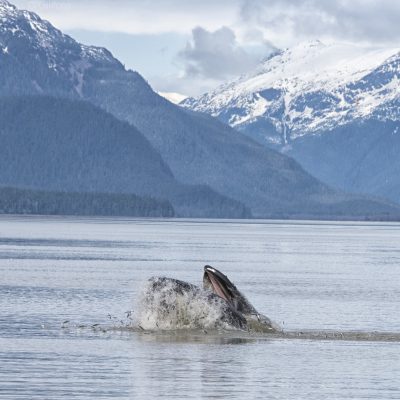Microplastic exposure increases in larger herring

“Humpback whale eat herring” by Gillfoto. CC BY-NC-SA 2.0.
Dorrie Woodward, chair of the of the Association for Denman Island Marine Stewards (ADIMS), describes springtime along the island’s shores and nearby waters as a marine “Serengeti.”
“A core aspect of being a Denman Islander is that each year you go through this amazing natural event,” Woodward said. “We’re all pretty vigilant about the herring, and feel protective and passionate about their wellbeing.”
That is why, when a report suggested that Denman Island’s waters could be full of microplastics – bits of plastic, smaller than five millimetres, that may harm fish and human health – the ADIMS, along with the K’ómoks First Nation Guardian Watchmen mobilized to uncover how big the problem was, and what could be done about it.
They enlisted the help of researchers at UBC’s Institute for the Oceans and Fisheries (IOF), who, using local knowledge of the area provided by members of the K’ómoks Nation, plus the equipment and energy of various community members, set to work collecting and analyzing samples of herring larvae, juvenile herring, and zooplankton.
What they found helps illuminate the study of microplastics in the ocean, an area of pollution research that is garnering lots of attention due to the many unknowns about how these particles damage the health of organisms that ingest them.
“The consumption of microplastics was surprisingly low in zooplankton and larval herring,” said Natalie Mahara, the lead author of a recently-published study and a graduate of the IOF’s master’s program. “The presence of microplastics became much more obvious when we looked at juvenile herring. The biological particles, like phytoplankton, that zooplankton eat are tiny. The natural prey of zooplankton and larval herring is incredibly abundant, and their chances of coming across similar sized microplastic particles are therefore very slim. But if you’re eating larger zooplankton, like juvenile herring do, you’re going to come across microplastics more frequently. The probability of ingestion increases with organism size, because the ratio of plastic to natural prey is higher.”
These findings suggest that juvenile herring have greater exposure, and potentially vulnerability, to microplastics than larval herring.
The research team expected to find larger amounts of microplastics in the water near towns and near shellfish fisheries. However, the tiny particles appeared in roughly the same concentrations in all of the sampled areas, regardless of proximity to the human settlements where plastic pollution originates.
“The tides are intense in this area, with currents moving all over the place,” Mahara said. “We’ve put a lot of microplastics into the environment and they get swished around; they get distributed easily. It was the same for the vertical distribution in the water column; they were spread evenly everywhere.”
Most microplastics identified by the study came from polyester fibres, likely shed from clothing in the laundry. Installing additional filters in laundry machines could stop some of the particles from entering the ocean, Mahara said.
Woodward said that she was relieved when the study’s results came back less dire than she anticipated.
“It takes something that was a threat or an emergency away, which allows us to focus on other concerns for sensitive habitat, since the shellfish growing industry is very active here in Baynes Sound,” she said, and added that she hopes the community can continue to work with scientists to assess these marine pollution threats over time, now that a baseline has be established.
However, the higher amounts of microplastics in juvenile herring do leave her concerned. “To me, it means that more work needs to be done,” she said.
Dr. Brian Hunt, the study’s senior author and an assistant professor at the IOF, agrees with Woodward’s cautionary words.
“There are still a lot of unanswered questions around the potential impact of microplastics on our marine ecosystems, and more needs to be done to understand them,” Hunt said. “Two areas of concern emerged for me during this study. One is all of the plastics we are not able to measure with current methods; particles smaller than microplastics that can be deposited or absorbed into an organism’s tissues. The other is all of the non-plastic particles that we found that looked like plastic. These particles, appear to be mostly material fibres, likely from human products. Of concern is the potential effects of chemicals or additives from these fibres, linked to treatments during material production, on our coastal food webs.”
The research also points to potential bioaccumulation pathways for microplastics though the food web in Baynes Sound and the Strait of Georgia, said co-author and IOF Research Associate Dr. Juan José Alava, who leads the Ocean Pollution Research Unit at IOF.
“The findings highlight the implications for the plausible bioaccumulation of microplastics in top predators such as sea lions, seals, and seabirds, as well as filter-feeding megafauna, including baleen whales foraging on Pacific herring, which is one of the most fundamental trophic level links to sustain the regional food web, the subsistence fisheries, and traditional seafoods of coastal communities in B.C.,” Alava said. “An additional topic deserving further attention and research is the short term (acute) and long term (chronic) toxicity caused by plastic particles per se in marine organisms.”
The study “Assessing size-based exposure to microplastic particles and ingestion pathways in zooplankton and herring in a coastal pelagic ecosystem of British Columbia, Canada” was published in the journal Marine Ecology Progress Series.
Tags: Aboriginal fisheries, Brian Hunt, British Columbia, coastline, faculty, herring, Indigenous fisheries, IOF Research Associates, Juan Jose Alava, Pelagic Ecosystems Lab, plankton, plastic, pollution, Research, zooplankton